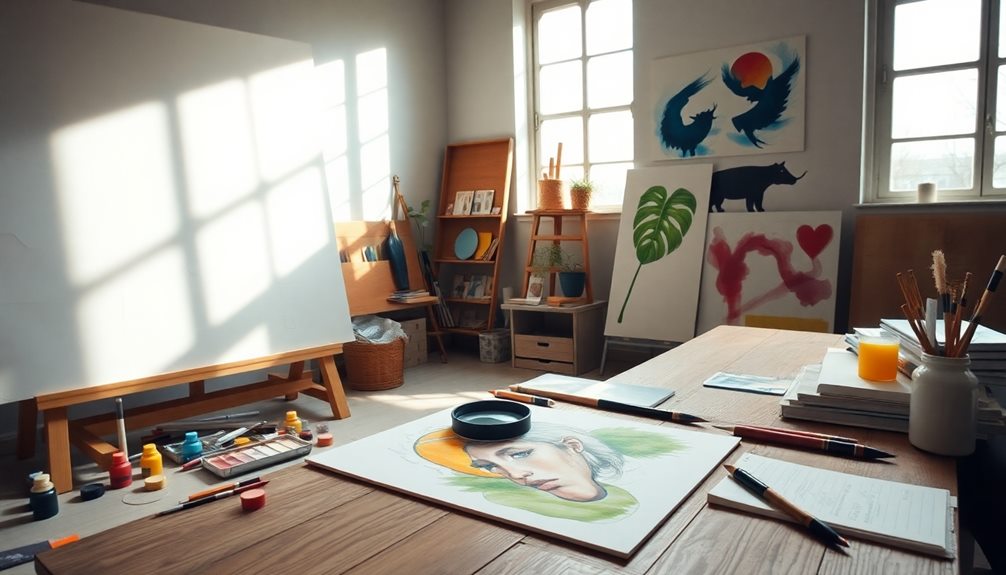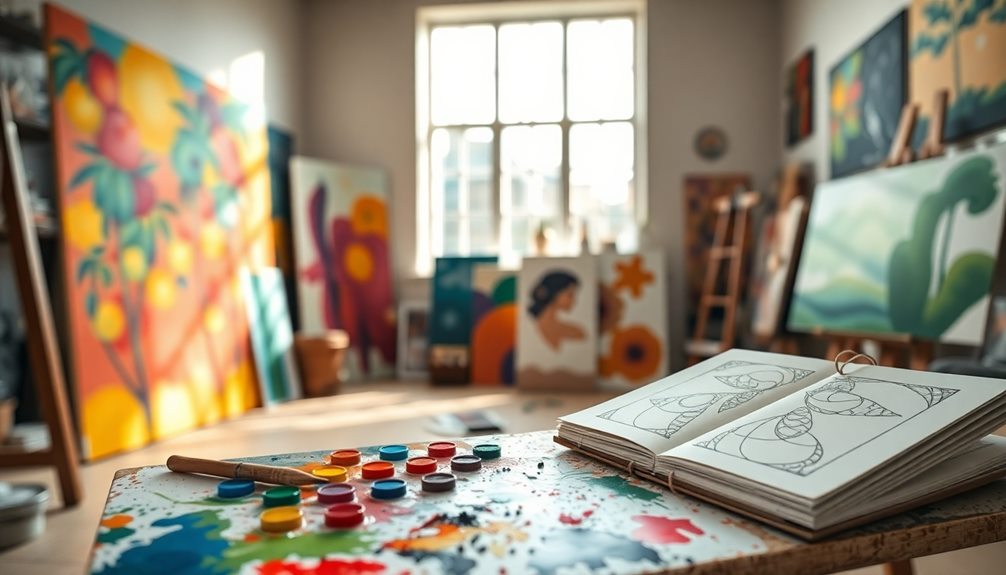You can enhance your appreciation for art by mastering the 5-Step Method for analyzing any artwork. First, see the piece closely and take note of its elements. Next, perceive the emotions it evokes. Then, ask questions and seek answers about the artist's intent and techniques. Reflect on how the artwork resonates with you personally. Finally, know the historical and cultural context that influences its meaning. This method guides you to a deeper understanding of the artwork and enriches your experience. Stick around, and you'll discover more insights that can elevate your art appreciation even further.
Key Takeaways
- The 5-Step Method includes See, Perceive, Ask + Answer, Reflect, and Know for comprehensive artwork analysis.
- Begin with close observation of visual elements like color, line, and texture.
- Engage emotions to explore personal feelings evoked by the artwork.
- Identify symbols and hidden messages to understand the artist's intentions.
- Reflect on personal experiences and cultural context to enrich interpretation and appreciation.
Introduction

When you dive into analyzing artwork, you unlock a world of meaning and emotion. This journey isn't just about looking; it's about engaging with the art on multiple levels. The 5-Step Method for Analyzing Any Artwork provides a structured approach that enhances your experience and understanding. Incorporating techniques from interior design basics, such as creating mood boards, can further enrich your analysis by visualizing the emotional landscape of the piece.
Starting with "See," you'll closely examine the artwork's content and subject matter. This step encourages you to observe the artistic choices and techniques that contribute to the piece.
Next, in the "Perceive" phase, you'll explore the emotions and meanings conveyed, allowing your sensory experiences to shape your understanding.
The "Ask + Answer" step urges you to think critically about the artwork's meaning. By identifying symbols and hidden messages, you'll delve deeper into its significance.
Then, "Reflect" prompts you to consider your personal connection to the piece, while "Know" emphasizes understanding the historical context.
Each of these steps fosters a comprehensive analysis, transforming your interaction with art into an enriching experience. By following this method, you won't just see art; you'll truly understand it.
Key Concepts and Definitions

Understanding key concepts and definitions is crucial for effectively analyzing artwork. Familiarizing yourself with terms like "design principles" and "formal analysis" can significantly enhance your interpretation skills.
Design principles refer to the guidelines artists use to organize visual elements in their work, such as balance, contrast, and unity. Recognizing these principles helps you appreciate how an artwork is constructed and the emotional responses it elicits. Additionally, engaging with your imagination's potential can further enrich your analysis by allowing you to envision multiple interpretations and meanings behind the artwork.
Formal analysis, on the other hand, involves examining the visual components of an artwork without considering its context or meaning initially. This method allows you to focus on aspects like color, line, shape, and texture. By observing how these elements interact, you can uncover the artist's techniques and intentions.
As you progress through the five-step method of analyzing artwork, understanding these concepts will lay a solid foundation. The steps—See, Perceive, Ask + Answer, Reflect, and Know—are designed to guide you through a comprehensive exploration of any piece.
Each step builds on the last, deepening your engagement and enhancing your ability to articulate your insights. Embrace these key concepts to enrich your analytical journey.
Analyzing Artistic Elements

Art's foundational elements—line, value, color, texture, shape, form, and space—are essential for a comprehensive analysis. When you dive into an artwork, focus on these elements of art, as each contributes to the overall composition and meaning.
Incorporating unique textures and colors can add depth and character, much like how antiques enhance country decor. Start by examining the lines; their quality and style can convey emotions and guide your gaze, shaping your interpretation.
Next, analyze the color schemes—whether they're complementary, analogous, or monochromatic. These choices significantly impact the mood and emotional resonance of the piece.
Don't overlook texture; whether it's rough, smooth, shiny, or matte, it adds a tactile dimension that enhances your experience and engagement with the artwork.
As you explore shape and form, consider how they interact within the piece. These elements can create balance and unity, key aspects of the principles of design.
Real-World Art Analysis Examples

Numerous real-world examples illustrate how the 5-Step Method can deepen your appreciation of artwork.
Take Vincent van Gogh's "Starry Night." You can start by observing the swirling sky (See), which evokes feelings of turmoil or wonder (Perceive). Then, you might identify themes of isolation and beauty (Ask + Answer), reflect on your own emotions tied to night scenes (Reflect), and explore van Gogh's mental state within the post-impressionist movement (Know).
Next, consider Grant Wood's "American Gothic." You see the stern expressions of the subjects (See), which can evoke a sense of seriousness (Perceive). You might ask questions about American identity during the Great Depression (Ask + Answer), reflect on your values regarding work and family (Reflect), and understand the socio-economic conditions of the 1930s (Know).
When analyzing Frida Kahlo's "The Two Fridas," you see the contrasting identities (See), feel the emotional struggle (Perceive), and analyze the symbolism (Ask + Answer).
Lastly, Banksy's "Girl with a Balloon" invites you to observe its poignant design (See), perceive themes of hope and loss (Perceive), and reflect on personal experiences with hope (Reflect).
Each example showcases the power of visual analysis.
Tips and Best Practices
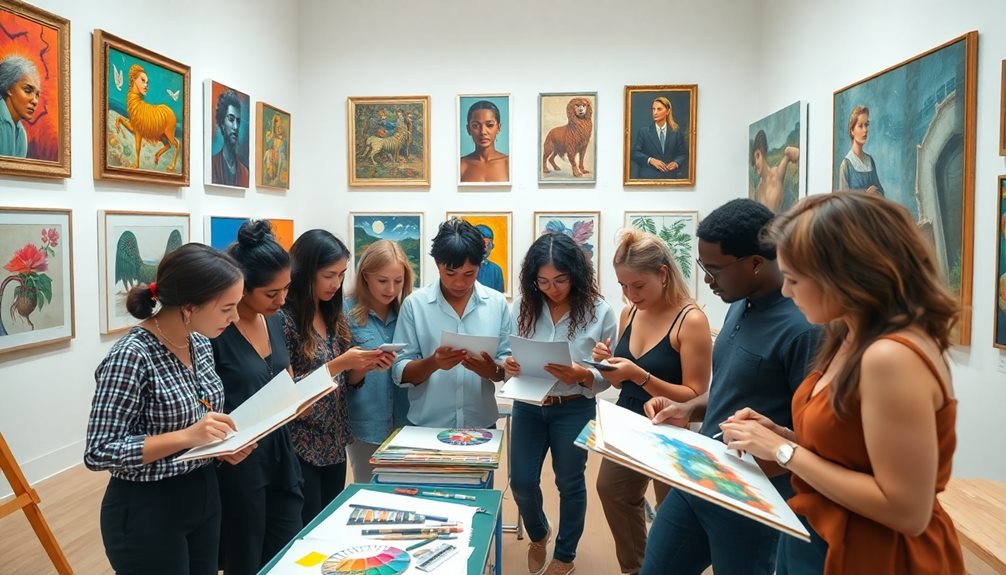
Start your analysis by closely observing the artwork, honing in on its content, subject matter, and the techniques the artist employs. This initial observation lays the groundwork for a deeper understanding of the work of art.
As you dive in, remember to engage your emotions; explore the feelings and moods the piece evokes. Use sensory language to articulate these experiences vividly.
Next, identify symbols and hidden messages, which can reveal the artist's intentions and choices. This critical thinking is essential for grasping the artwork's meaning.
Reflect on your personal experiences in relation to the piece; consider how it resonates with your beliefs and perspectives to enrich your understanding.
Additionally, research the historical context surrounding the artwork. Investigate the artist's background and the cultural influences at the time of creation. This knowledge not only enhances your appreciation of its significance but also helps you apply various principles of art analysis effectively.
Audience's Emotional Responses

Emotional resonance plays a crucial role in how audiences connect with artwork, creating a dynamic interplay between the viewer and the piece. Your audience emotional responses can vary widely, shaped by personal experiences and cultural backgrounds. This diversity leads to a rich tapestry of meanings, revealing how each viewer interprets the artist's vision.
The mood established by the artwork—through its color palette, subject matter, and texture—can evoke feelings like joy, sadness, or nostalgia. These initial emotional reactions are essential, guiding you toward a deeper analysis that uncovers what the artist wanted to convey. For instance, a vibrant color scheme might spark happiness, while darker tones could incite contemplation or sorrow.
Sensory descriptions play a vital role in discussing art, allowing you to articulate your feelings and share emotional experiences with others. By doing so, you not only enhance your understanding but also connect with the broader societal sentiments present when the artwork was created.
Recognizing this context helps you appreciate the emotional landscape that both the artist and viewers navigate, enriching your overall experience with the piece.
Audience Interpretation Variability
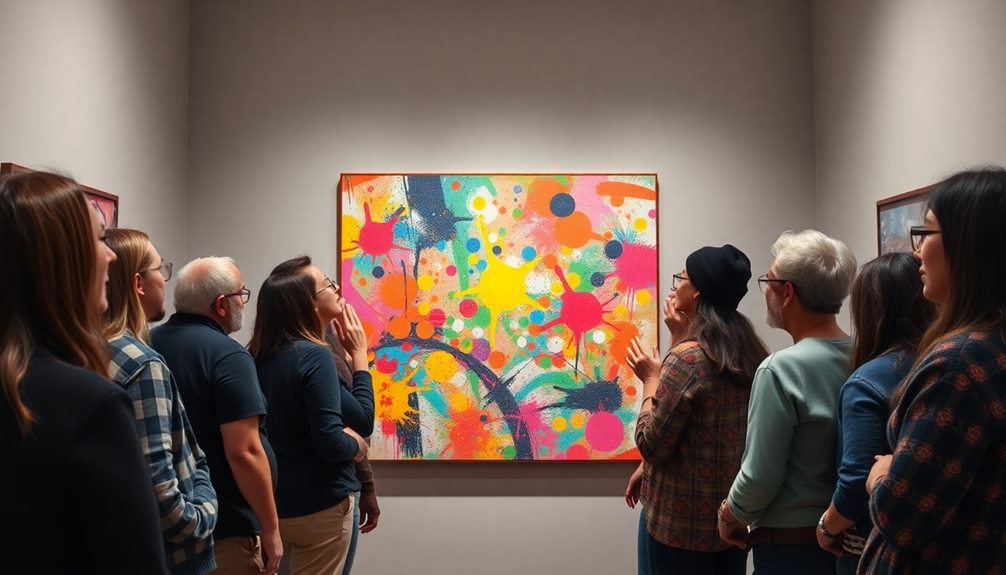
While viewing a piece of artwork, your interpretation can differ dramatically from that of others, influenced by your personal experiences and cultural background. This audience interpretation variability can lead to a rich tapestry of meanings surrounding the same subject matter.
For instance, factors like age, education level, and exposure to different art forms shape how you perceive visual elements and themes. Your emotional state at the time of viewing can also play a significant role in how you connect with the artwork. A piece that resonates deeply with you may evoke different feelings in someone else, highlighting the subjective nature of art appreciation.
Moreover, the historical context in which you experience the artwork can shift its relevance and meaning. Contemporary events may alter how you interpret the piece, sometimes diverging from the artist's original intent. This results in layered meanings that vary widely among viewers.
Ultimately, engaging with art relies heavily on your individual sensory experiences. These personal connections are crucial in shaping your interpretation, underscoring the beauty of audience interpretation variability in the world of art.
Additional Resources
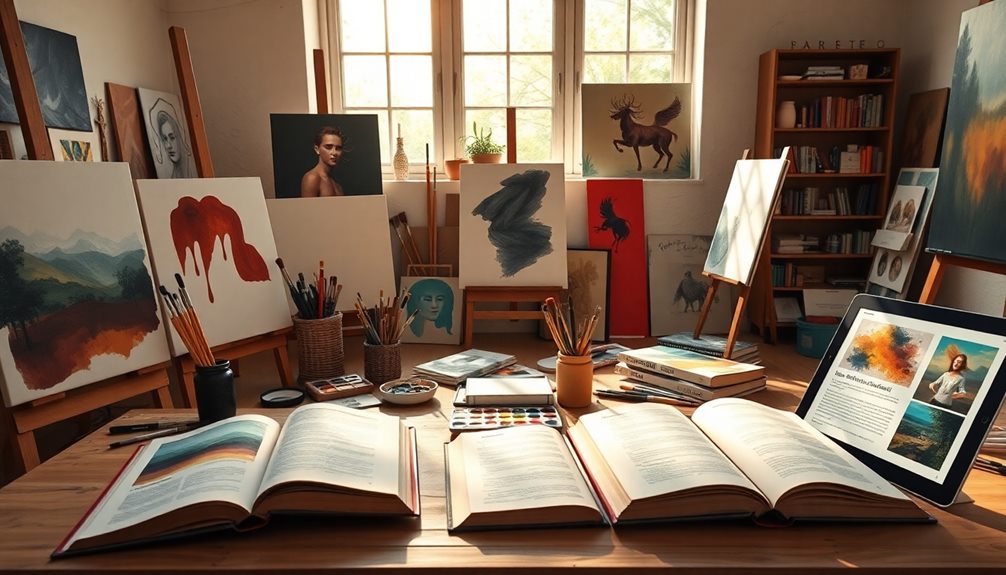
To dive deeper into the world of art analysis, you can tap into a variety of resources that enhance your understanding and appreciation. Books and online courses on art history can provide you with a solid foundation, helping you grasp the context in which an artist creates.
Familiarize yourself with various techniques and styles that artists use; this knowledge is an important part of your analysis process. Art museums often offer guided tours or educational programs, which can give you valuable insights into specific artworks and their creators. Engaging with these resources encourages you to explore the emotional responses that art evokes, a key component of the Reflect step in the 5-Step Method.
Additionally, documentaries and podcasts about artists or art movements can deepen your understanding of the broader historical narratives surrounding particular pieces.
Don't forget to join online forums or local art groups where you can discuss your interpretations with others. This interaction not only sharpens your critical thinking skills but also exposes you to varied perspectives, enriching your overall experience in analyzing artwork.
Frequently Asked Questions
What Are the 5 Steps in Analyzing Art?
To analyze art, you observe the content, feel the emotions, ask about the meaning, reflect on personal connections, and research the artist's background. Each step deepens your understanding and appreciation of the artwork.
What Are the 5 Things Do You See in the Artwork?
You notice key figures standing out, vibrant colors that evoke emotion, dynamic lines guiding your gaze, intriguing textures inviting touch, and a balanced composition that harmonizes all elements, creating a captivating visual experience.
What Are the 5 Processes of Art?
When you create art, you engage in five processes: conception, where ideas form; execution, where you bring those ideas to life; revision, refining your work; presentation, sharing it; and reflection, assessing its impact on you and others.
What Are the 5 Key Elements in Art Criticism?
In art criticism, you'll focus on five key elements: description, analysis, interpretation, judgment, and context. Each element helps you understand and evaluate the artwork's visual characteristics, meaning, and significance within its cultural framework.
Conclusion
In conclusion, using this 5-step method can transform how you approach any artwork. By breaking down key concepts, analyzing elements, and considering emotional responses, you'll gain deeper insights into each piece. Remember, your interpretation might differ from others, and that's what makes art so powerful. So, dive in, explore, and let your unique perspective shine. With practice, you'll become more confident in your analysis and appreciation of art. Happy exploring!
